T-Th 9:05
or
T-Th 11:15
in Olin 155
CS 1110: Introduction to Computing Using Python
Fall 2016
About:
Announcements
Staff
Consultants
Times & Places
Calendar
Materials:
Texts
Python
Command Shell
Terminology
VideoNote
Handouts:
Lectures
Assignments
Labs
Assessment:
Grading
Exams
Resources:
CMS
Piazza
AEWs
FAQ
Python API
Python Tutor
Style Guide
Academic Integrity
Assignment 4:
Turtles
Due to CMS by Thursday, October 27th at 11:59 pm.

Computer graphics can be tricky, and you often need a lot of experience with programming before you can get started. However, for over forty years, the LOGO Turtle has allowed elementary-school students to draw cool and interesting shapes on their computer. And if they can do it, so can you.
The Turtle is a cursor on the screen that uses a Turtle for its icon. To draw a line, you push the Turtle forward. The screen draws a line of the same color as the Turtle (which can be changed at any time) along its path of movement. To draw more interesting shapes, you simply change the direction of the Turtle. With a few more commands you can even draw solid shapes.
While programming languages have come a long way since the early days of LOGO, the graphics Turtle lives on. Every major programming language, from C/C++ to Java to Python, has a version of the Turtle. For today's assignment you get to participate in this 50 year tradition, and hopefully have some fun in the process.
This assignment is a little harder than the previous one, but you have two full weeks to work on it. In the past we have found this to be more than enough time for this assignment. But get started early! If you do not know where to start, or if you are completely lost, please see someone immediately: either the instructor, a TA, or a consultant. A little in-person help can do wonders.
Again, please remember to fill out the survey telling us how long you worked on this assignment.
Update October 16: Apparently Anaconda caused some serious issues with the tkturtle.py module. We have created a new version of this module and made it available in the assignment resources below. Make sure to put this file in the same folder as your file a4.py
Learning Objectives
This assignment serves several important roles.
- It introduces you to the famous Turtle, which is a great way to learn a new language.
- It gives you experience with writing simple for-loops.
- It gives you experience with recursion.
- It gives you experience with complex objects that have both attributes and methods.
- It gives you experience with using asserts to enforce your preconditions.
Table of Contents
Authors: D. Gries, W. White, L. Lee, S. Marschner.
- Academic Integrity and Collaboration
- Turtle Graphics
- Assignment Instructions
- Asserting Preconditions
- Task 1. Triangles
- Task 2. Hexagons
- Task 3. Radial Shapes
- Task 4. Simple Recursive Shapes
- Task 5. 3-Branches Tree
- Finishing the Assignment
Academic Integrity and Collaboration
Academic Integrity
This is a classic assignment that is returning after a short break because students really like it. But when we say classic, we mean really, really old. While we did mix it up a bit this year, there are guaranteed to be solutions to many of these problems in the wild. Please avoid looking at solutions online, or looking code from other students this semester, or semesters previous.
In this assignment, it is highly unlikely that your code for this assignment will look exactly like someone else's. We will be using Moss to check for instances of plagiarism. If you do collaborate with another person, you should clearly state this in your module comments; otherwise, this may result in an Academic Integrity hearing. Furthermore, even if you do properly cite, we still may deduct points from your final score. Try to do this assignment on your own.
Collaboration Policy
You may do this assignment with one other person. If you are going to work together, then form your group on CMS as soon as possible. If you do this assignment with another person, you must work together. It is against the rules for one person to do some programming on this assignment without the other person sitting nearby and helping.
If you do talk about this assignment with someone outside your group, please note this in both the header docstring for a4.py, as well as the function specification for the part that you talked about. We will not hold an academic integrity hearing if you cite the collaboration. However, we may still deduct points from your grade.
Turtle Graphics
Python actually has a built-in Turtle provided by the turtle module.
However, we find this module a bit confusing to use, particularly for a beginner.
Instead, we provide an alternative Turtle, which we call the Tk Turtle.
This Turtle is in the module tkturtle which was installed as part
of Cornell Extensions. You will be using this module together with some additional
files.
Assignment Source Code
At first glance, this assignment is much more bare-bones than previous ones. There is only one file to download:
a4.py- This is file contains stubs for all the functions in this assignment, and is the file you will submit for a grade.
However, some of you have been having trouble with either tkturtle.py or colormodel.py. These changes have been caused by the move to Anaconda from ActiveState in previous years. If you are having troubles, you should download the following three files (which should all go in the same folder as a4.py):
tkturtle.py- This is an alternate version of tkturtle experiencing problems with getting the turtle to move.
colormodel.py-
This is an alternate version of colormodel for students having problems
with the
_TK_COLOR_MAP(which converts color names, like 'blue' to color values). pen.gif-
This is the icon for the
Pentool. If you download a new colormodel, you must download this as well.
You you want all of these files, they are zipped together (with a4.py) into a single file.
To save you time, we have given complete specifications of most of the functions you are to write. Study them carefully. Note how precise and thorough they are. You should aim for this level of quality when you start to write your own specifications.
You will not be creating a test script this time. Writing test cases for graphics is almost impossible. Therefore, you will be looking at the the drawings produced by your functions to determine correctness.
However you will notice that you can actually run a4.py as a script.
Run it as a script by typing
python a4.py
You will see that it asks you yes/no questions. Answer 'y' to this first question. The turtle will draw two lines for you. In general, answering 'y' will call the specific drawing function so that you can test it. Any other answer will skip over that drawing function. Since drawing can take a long time, this allows you a nice way to test only the specific drawing function that you are working on. However, right now it does not do much. That is because you have not started on the assignment.
If you want more control over your testing, you will need to import the functions
of a4.p manually. To do this, you need to understand the
tkturtle module a bit more. This module provides three classes:
Window, Turtle, and Pen.
Window
To create a window, you use the constructor Window() and assign
the result to a variable. Try this command at the interactive prompt:
>>> import tkturtle >>> w = tkturtle.Window()
This will display a window on your screen. The window object has several attributes that you can change.
| Attribute | Meaning | Invariant |
|---|---|---|
| w.x | x-coordinate of top left corner | Must be an int |
| w.y | y-coordinate of top left corner | Must be an int |
| w.width | Width of the window in pixels | Must be an int |
| w.height | Height of the window in pixels | Must be an int |
| w.title | Title at top of window | Must be a string |
Try changing the values of these attributes (with assignment statements). For example, what happens when you type the following command:
>>> w.width = 100
In addition, there are two important methods:
w.clear()- This erases the contents of the Window. It also detaches any Turtles so that they no longer work.
w.bye()- This closes the Window permanently.
Turtle
The Turtle class is used to draw on your Window. Each Turtle object t
has the following important attributes:
| Attribute | Meaning | Invariant |
|---|---|---|
| t.x | x-coordinate of the Turtle | Must be an int or float. Cannot be altered directly |
| t.y | y-coordinate of the Turtle | Must be an int or float. Cannot be altered directly |
| t.heading | Turtle heading in degrees counter-clockwise from east. | Must be an int or float. |
| t.color | Current Turtle color | Must be a string, an RGB object, or an HSV object. |
| t.speed | The drawing speed of this Turtle. | Must be an int 1 (slowest) to 10 (fastest), or 0 (instantaneous) |
| t.visible | Whether the Turtle icon is visible. | Must be a bool |
| t.drawmode | Whether the Turtle should draw anything when it moves; if False, nothing is drawn. | Must be a bool |
To create a Turtle, you use the constructor Turtle() which takes a single
argument: the Window that you want to draw on. Assuming that you made a Window object
w in the previous section, try the following at the interactive prompt:
>>> t = tkturtle.Turtle(w)You should now see a (red) Turtle on your Window!
The fact that Turtle and Window are separate allows you to have as many Turtles as you
like so that you can draw different things with them. If at any time you have too many
Turtles, use the method w.clear(). This removes all Turtles from the
Window (which means that attempts to do anything with any old Turtles will fail),
so you will need to add a brand new Turtle to start drawing again.
Position and Orientation

The position and heading of the Turtle are maintained using floating point numbers. This is needed for accuracy. If integers were used, errors would be introduced after only a few calculations. However, whenever a point is to be drawn in the window, its x- and y-coordinates are rounded to the nearest integer because the pixel coordinates are represented as integers.
The direction of the Turtle is called its heading. It is a number representing the angle in degrees counterclockwise from east (to the right). Thus east is 0 degrees, north is 90 degrees, west is 180 degrees, and south is 270 degrees. Negative angles and angles greater than 360 are allowed; the remainder modulo 360 is used.
While the heading attribute can be modified, the x and y
attributes cannot. You can only control the Turtle's position via the methods listed below.
Important Methods
In addition to its attributes, a Turtle object t has several important methods:
t.forward(dist)-
Moves the Turtle
dist pixels in the direction of its current heading. If the drawmode is True, a line is drawn; otherwise, no line is drawn. t.backward(dist)-
Moves the Turtle
distpixels in the opposite direction of its current heading. If the drawmode is True, a line is drawn; otherwise, no line is drawn. t.left(a)-
Rotates the Turtle in place
adegrees counterclockwise. t.right(a)-
Rotates the Turtle in place
adegrees clockwise. t.move(x,y)-
Moves the Turtle
tto pixel(x,y)without drawing anything.
Note that most of these methods are used to move the Turtle about the screen. This
is why the attributes x and y cannot be altered directly
(e.g. you cannot assign values to them). You should use these methods instead.
Colors
To change the Turtle color, you assign a new value to the color attribute.
You can use the RGB and HSV objects from the last assignment.
You will need to import the colormodel module to do
this. You cannot use a CMYK object with a Turtle; that color model is
designed for printing, and not for displaying on your screen.
The Turtle also supports strings as colors. Just put the name of the color that you want in quotes; make sure the name is all lower case. For example, to make your Turtle blue, try
>>> t.color = 'blue'
Speed
As you will discover with this assignment, the turtle can be quite slow. You can control the speed of the Turtle by setting is speed attribute. It is a number in the range 1 ≤ speed ≤ 10, with 1 slowest and 10 fastest. You can also set the speed to 0, which causes shapes to be drawn with no animation. However, even when the speed is set to 0, you will see the the Turtle draw each line individually, so sometimes shapes can take a while to draw (this is an unfortunate issue with the way the Turtle is implemented in Python).
Drawing with the Turtle
Throughout this assignment, you will be asked to draw shapes with a Turtle.
There are three ways to do this. The first is to type Turtle commands
directly in the Python interactive shell. You should do this right now to
familiarize yourself with the Turtle class and its methods.
For example, try these commands:
>>> import tkturtle >>> w = tkturtle.Window() >>> t = tkturtle.Turtle(w) >>> t.color = 'green' >>> t.forward(100) >>> t.color = 'red' >>> t.right(90) >>> t.forward(150)
As you type the lines up to and including t = tkturtle.Turtle(w), you will
see a window appear with a Turtle at the center facing west. As you type the other
commands, the Turtle will change color, move, and draw lines.
The second way to draw is to add new procedures to the module a4.py and
call them from the interactive prompt. If you look at the file, you will notice that
it contains a procedure draw_two_lines. We gave you this procedure to
show you how to write a graphics procedure. Note that it takes the Window object as
an argument, so it does not create a new window. It also does not clear the Window,
though we might want our other functions to do that. All it does is create a Turtle,
and use that Turtle to draw two lines.
To try out this function, navigate to the directory containing the file a4.py and
start up the interactive prompt. Then type:
>>> import tkturtle >>> w = tkturtle.Window() >>> import a4 >>> a4.draw_two_lines(w,2)
This will draw two lines in the window w, at speed 2. Study the body of draw_two_lines,
as it will help you with all of the tasks in this assignment.
For the remainder of this assignment, you will be writing procedures that draw shapes,
much like draw_two_lines. As you write a procedure, refer constantly to
the specification. Follow it carefully. If you have to call another procedure, look
at its specification and make sure you follow it. A huge number of programming errors
arise from not following specifications carefully.
Pen
Objects of type Pen are very similar to Turtle objects, except that they draw a bit differently. Creating a Pen is similar to creating a Turtle. At the interactive prompt try
>>> import tkturtle >>> w = tkturtle.Window() >>> p = tkturtle.Pen(w)
You should now see a pencil icon on your Window. If you do not, please post on Piazza, as that is a sign of a bigger problem.
A Pen object has a lot of attributes in common with Turtle. However, it
does not have a heading attribute. Instead, for a Pen object p,
you draw with the following methods.
p.drawLine(dx,dy)-
Draws a line starting from the current Pen position with distance
dxpixels along the x-axis anddypixels along the y-axis. p.drawCircle(r)- Draws a circle of radius r (in pixels) centered at the current Pen position.
p.move(x,y)-
Moves the Pen
pto pixel(x,y)without drawing anything.
Solid Shapes
The Pen also does not have a drawmode attribute. The three methods listed
above either always draw (drawLine, drawCircle) or never draw
(move). Instead, the Pen has a fill attribute. When this
attribute is True, the Pen will enter into a "fill mode". Anything that is drawn between
now and when the attribute becomes False (or when a call to move is made)
will result in a solid shape.
For example, to draw a solid square, try the following sequence of commands with your Pen.
>>> p.fillcolor = 'blue'
>>> p.fill = True
>>> p.drawLine(0,50)
>>> p.drawLine(50,0)
>>> p.drawLine(0,-50)
>>> p.drawLine(-50,0)
>>> p.fill = False
When you finish, the pen will fill the insides of the square with the color blue.
Because the pen can draw solid shapes, it actually has two color attributes:
fillcolor and pencolor (there is no simple color
attribute in Pen). The fillcolor is the color it uses
inside a solid shape, and pencolor is the color for hollow shapes
as well as the border of solid shapes.
Assignment Instructions
This assignment is broken up into four tasks. Each task corresponds to a
procedure stub (or collection of stubs) in a4.py. You will find
this assignment to be a lot easier if you complete and fully test one task
before moving on to the next.
We do not require that you make a test module this time. We have
provided the test procedure main() which calls the various
drawing functions. It is the procedure called when you run the module as
a script. Feel free to make any changes that you wish to this function.
We will not look a the body of this function when we grade your assignment.
Asserting Preconditions
As we saw in class, it is very helpful to assert your preconditions when you are using recursion or iteration. This keeps you from being caught in an (effectively) infinite loop.
Through out the code in a4.py, we have placed assert statements
in the various function stubs. However, we do not guarantee that they are enough.
When you complete a function, we expect that you fully check your precondition with
assert statements. If the provided assert statements do not fully check your
precondition, then you must add more.
To help you with this process, we have provided you with several helper functions
at the very top of a4.py. All of these helper functions return
a boolean value: True or False. These helper functions
are to be used inside of an assert to check part of a precondition, as shown
throughout the code.
As we saw in class, it is quite common to use helper functions to check preconditions.
Some of the preconditions in this assignment can be quite complex. In particular,
look at the function for is_valid_color(). This allows us to simplify
our assert statements a lot.
You will also notice that we have a helper function called report_error.
In the past, we discovered that students are quite prone to make coding mistakes in
their assert error messages (particularly adding a non-string to a string). This
function is a nice way to make error messages that is fairly foolproof.
Task 1. Triangles
Complete the procedure draw_triangle(t,s,c). This procedure is given a
Turtle as a parameter. You do not need to make a new Turtle, nor a new Window.
This procedure should draw an equilateral triangle of side length s and
color c using Turtle t. It should draw the triangle using
t's current position and orientation. The Turtle should end its drawing
at the same position and orientation as when it started. Do not save
the Turtle's position and orientation at the beginning and then restore them at the end.
If you draw the triangle correctly, following the instructions in the procedure
specification, then this should happen automatically.
To try out the procedure, type the following in interactive mode.
>>> import tkturtle
>>> import a4
>>> w = tkturtle.Window()
>>> t = tkturtle.Turtle(w)
>>> a4.draw_triangle(t,200,'green')
Task 2. Hexagons

Complete the procedure draw_hex(t,s). This method should draw six equilateral
triangles using color 'orange' with side lengths s.
This triangles should form a hexagon, as illustrated to the right. Follow the specification
and hints carefully. In particular, be sure to use the helper function suggested. Do not
try to repeat code already written.
For both draw_triangle and draw_hex, it is very important
that you follow the specifications. If you do not follow the specifications exactly,
we will deduct points. In particular, pay close attention what we say about the state
of the Turtle. Did you make any changes to Turtle attributes that need to be changed
back to what they were orginally?
Task 3. Radial Shapes
Choose two (and only two!) from the following three activities: spirals, polygons, or radiating lines. Once you have done two of these, you are free (but not required) to do the remaining one. These are pretty fun assignments. If you decide to do all three, we will grade you on the best two (though there is no extra credit beyond that).
Each of these tasks involves creating a helper procedure. In each case, the main procedure
does not have a Turtle as parameter, but its helper procedure does. The main procedure
clears the Window, creates a Turtle, calls the helper procedure to do the work, then hides
the Turtle. Note that some of these procedures are very particular about which way that
the newly created Turtle should start out facing. Remember that you can control the
facing of your Turtle via the heading attribute.
When writing these procedures, write the main procedure first, then the helper,
and finally test both by calling the first one in python.
If the main procedure is foo, its associated helper is called
foo_helper. We have created stubs for all of these procedures in
a4.py. Do not change the headers (either the names or the parameters),
as our grading software will be calling them by those names. Just fill in the bodies.
Once again, it is very important that you follow the specifications for all three procedures below. If you do not follow the specifications exactly, we will deduct points. Pay close attention what we say about the state of the Turtle. Did you make any changes to Turtle attributes that need to be changed back to what they were orginally?
Spirals
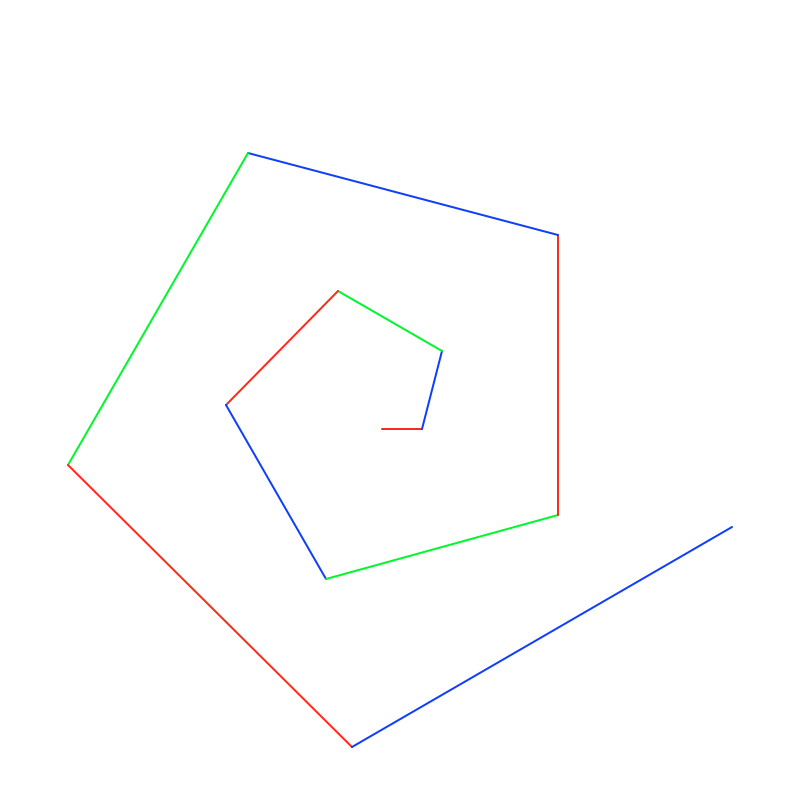
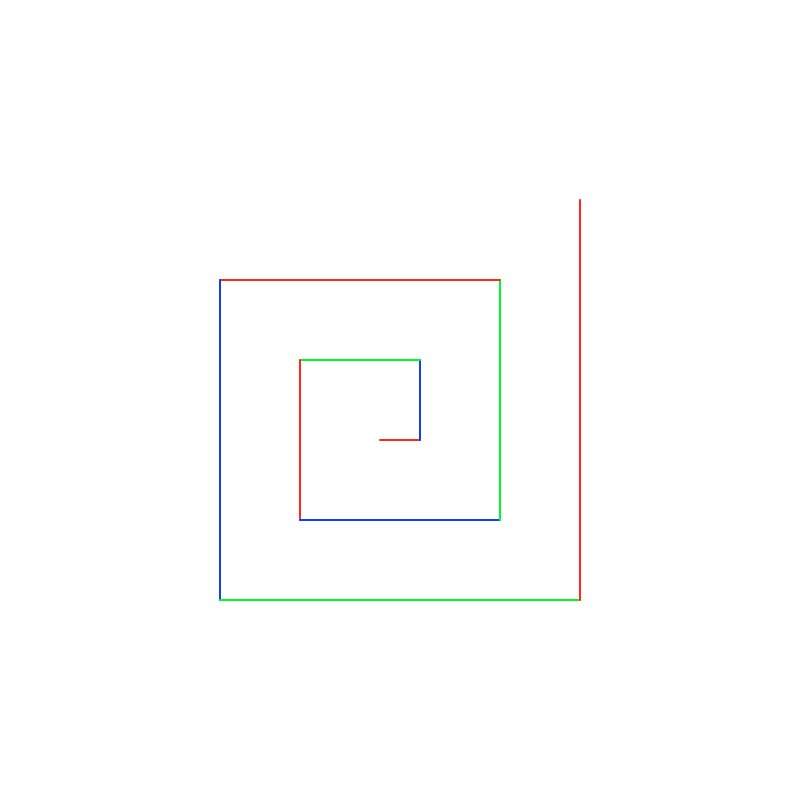 The first picture to the right is done by drawing 10 lines. The lines have length
10, 20, 30, ... . After each line, the Turtle turns left 90 degrees. The second
diagram to the right shows a similar spiral but with the Turtle turning left 75
degrees after each line.
The first picture to the right is done by drawing 10 lines. The lines have length
10, 20, 30, ... . After each line, the Turtle turns left 90 degrees. The second
diagram to the right shows a similar spiral but with the Turtle turning left 75
degrees after each line.
Complete the procedures draw_spiral and draw_spiral_helper.
Pay close attention to how the lines grow at each step. Also pay close attention
to how these change color. These are all import parts of the specification.
When you first test these function, use 10 for the initial side length.
Try different angles, like 90 degrees, 92 degrees, 88 degrees, and so on.
You will be amazed at what these procedures do. Find out by trying these calls
(after creating the Window w):
draw_spiral(w, 8, 90, 300, 10) draw_spiral(w, 8, 135, 400, 10) draw_spiral(w, 9, 60, 100, 10) draw_spiral(w, 9, 121, 500, 10) draw_spiral(w, 10, 89, 400, 10) draw_spiral(w, 10, 150, 300, 10) draw_spiral(w, 10,-144, 500, 10)
Polygons
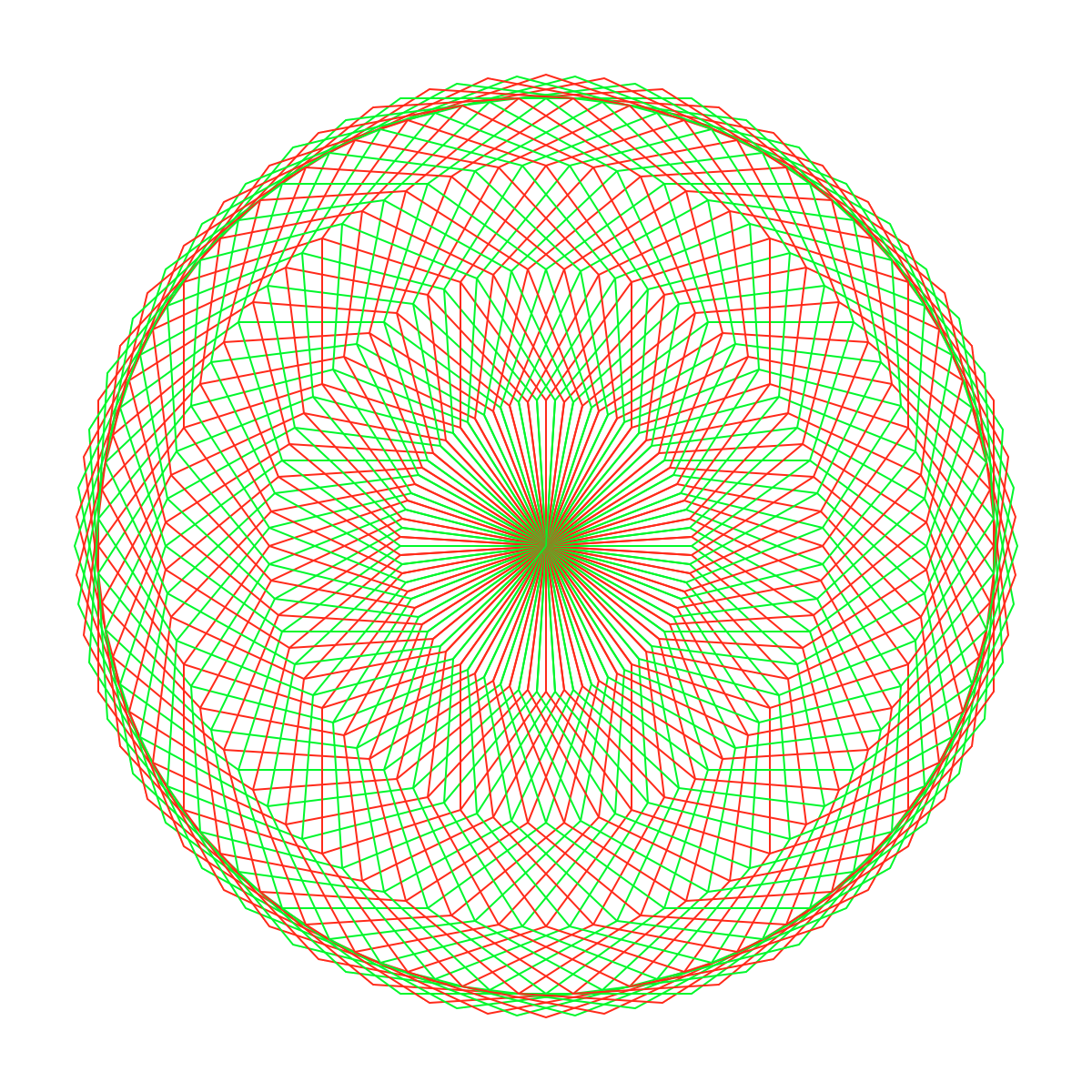
 The first image to the right is a 10-sided polygon. The second image to the right is
a series of 100 10-sided polygons, the first started at angle 90, the second at an
angle of 90 + 360.0/100, the third at an angle of 90 + 2*360.0/100, and so on. This
demonstrates the kind of cool pictures you can draw just with polygons.
The first image to the right is a 10-sided polygon. The second image to the right is
a series of 100 10-sided polygons, the first started at angle 90, the second at an
angle of 90 + 360.0/100, the third at an angle of 90 + 2*360.0/100, and so on. This
demonstrates the kind of cool pictures you can draw just with polygons.
Complete the procedures multi_polygons and multi_polygons_helper
so that your program can draw such designs. You should use the procedure draw_polygon,
which we have provided, as a helper function (do not modify this procedure).
You should also pay attention to the color alternation. As you can see in the
100 polygon picture, we alternate the color red and green.
When your are finished, experiment to see what neat designs come out. For example,
try the following (after creating the Window w):
multi_polygons(w, 45, 3, 100, 10) multi_polygons(w, 60, 30, 20, 10)
Radiating Lines
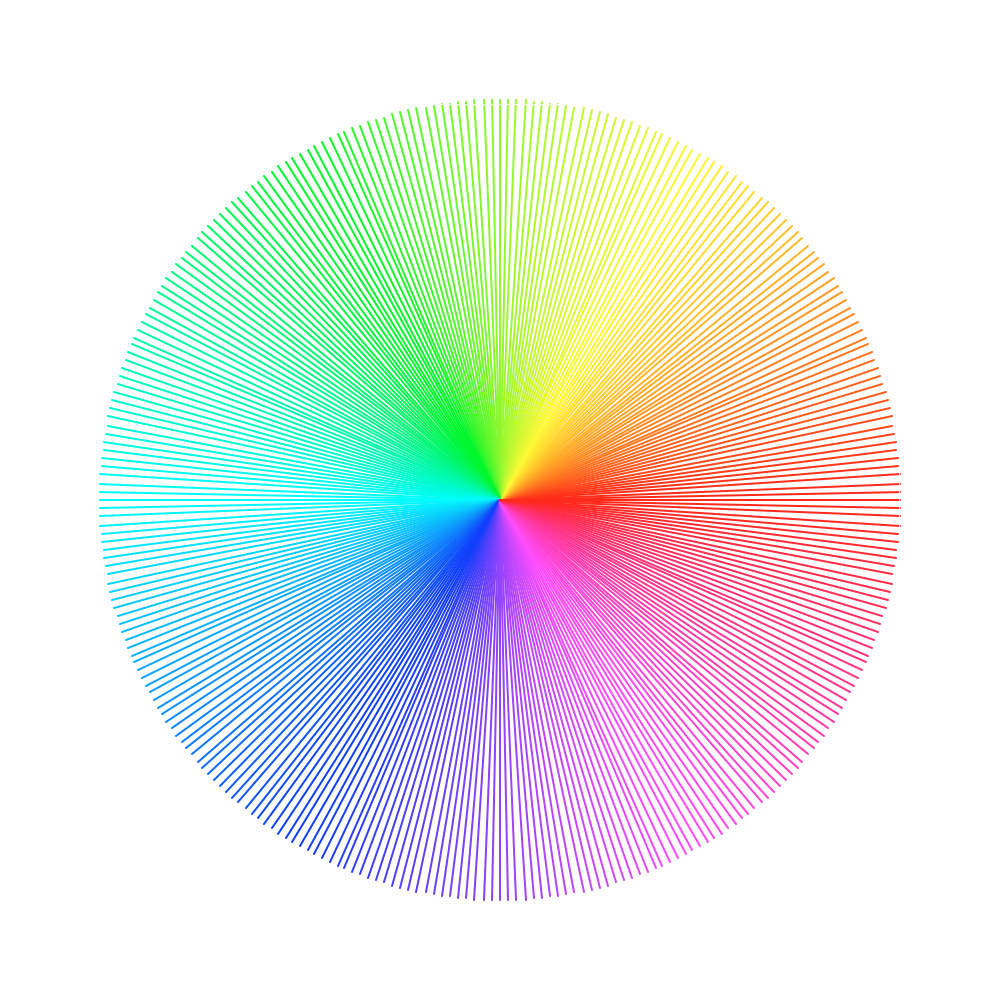
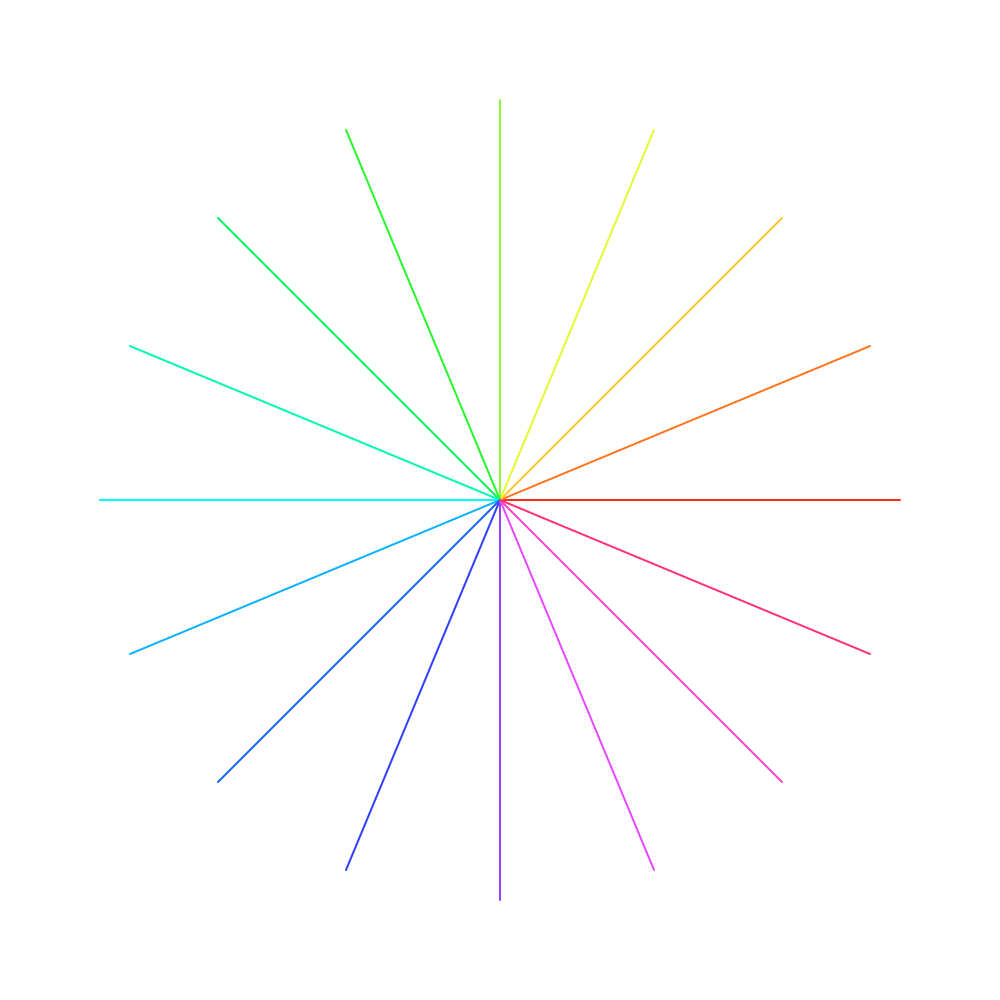 The picture on the left consists of 16 lines of the same length radiating out from the
initial Turtle position. The angle between the lines is the same. The second picture
has 300 lines. If
The picture on the left consists of 16 lines of the same length radiating out from the
initial Turtle position. The angle between the lines is the same. The second picture
has 300 lines. If n lines are drawn, the angle between them is
360.0/n. Furthermore, the color of each line depends on the angle
(i.e. the direction) of each line.
Note that the Turtle color attribute will accept HSV objects. A line drawn at angle
ang uses the color HSV(ang, 1.0, 1.0). Just assign
the object to the attribute and start drawing. This should make this part of the
assignment fairly straightforward. Remember the invariants
for an HSV object when you are drawing.
Complete the procedures radiate and radiate_helper. When
finished, test them with small values of n, like 4 or 8. After the
procedures are completely tested, try them with 360 lines of length 200. Also,
try 2000 lines and Turtle speed 0 (which still takes a while because of how the
Turtle draws), and notice how much more filled in the disk becomes.
Task 4. Simple Recursive Shapes
In this next two tasks you will draw some fractals. A fractal is a shape that has parts which (when you zoom in) look like the whole shape. This suggests that you will need to use recursion to draw them. The number of recursive steps (or depth) determines the resolution of the fractal drawn. Wikipedia has a wealth of information about these and other fractals.
This time you are to choose one (and only one) from the following two shapes: the Cantor stool or the Sierpinski triangle. Once again you are free (but not required) to complete them both. If you do both of them, we will grade the best one.
Throughout both of these tasks, we ask that you use a Pen instead
of a Turtle because (1) there is no need to maintain the direction and
(2) Pen methods can draw solid shapes. See the
overview of the Pen above for more information.
As with the radial shapes, for each of these recursive tasks, you will implement two procedures, a main procedure and a helper. The main procedure clears the Window and creates a new Pen. It also calls the helper to do the drawing, then cleans up afterward. The main procedure does not have a Pen as a parameter (though it does have the Window as a parameter), while the helper does.
The helper is the function that does all the real drawing. It is the function that is supposed to call itself recursively. The main procedure is not recursive.
Once again, it is very important that you follow the specifications for all three procedures below. If you do not follow the specifications exactly, we will deduct points. Pay attention to when the Pen should and should not be visible.
Cantor Stools
The Cantor stool is a 2-dimensional version of the
Cantor set. The legs of the stool
are formed by the recursive calls beyond the base case. Below are the Cantor stools for
depths 0, 1, 2, and 3 respectively. The width of each stool stool is side and
the height of the stool is hght. In depth 0, there is no recursive call and
so the stool is a simple rectangle. In depth 1, there is a single recursive call, and
the stool was cut in half vertically. The horizontally, the legs take up the first and
last third of the width. In depth 2, the legs of the stool are themselves stools.
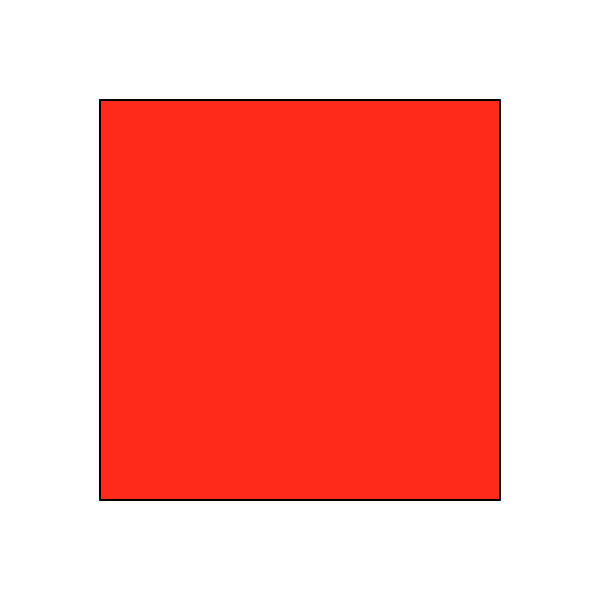 |
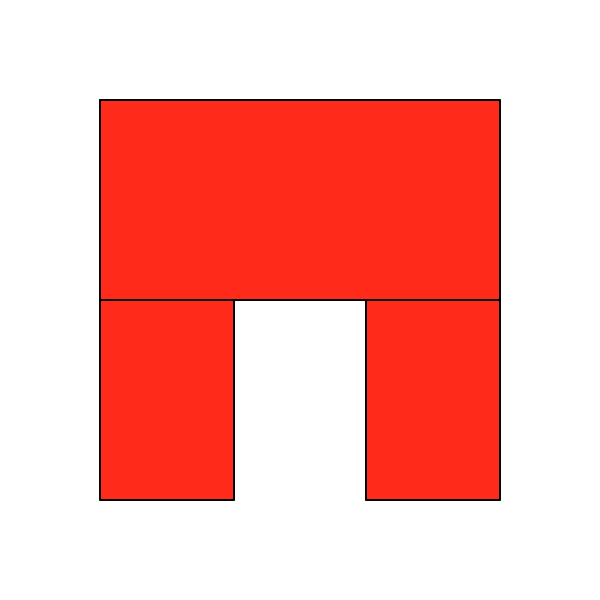 |
 |
 |
| Depth 0 | Depth 1 | Depth 2 | Depth 3 |
In general, we construct a Cantor stool as shown below. In the base case, we draw a simple
rectangle. For later depths, divide the rectangle in half vertically, drawing a rectangle
with width size and height hght/2. For the legs, draw stools
of one less depth whose width is size/3. You will need to reposition the
stools so that they line up with the edges of the top rectangle.
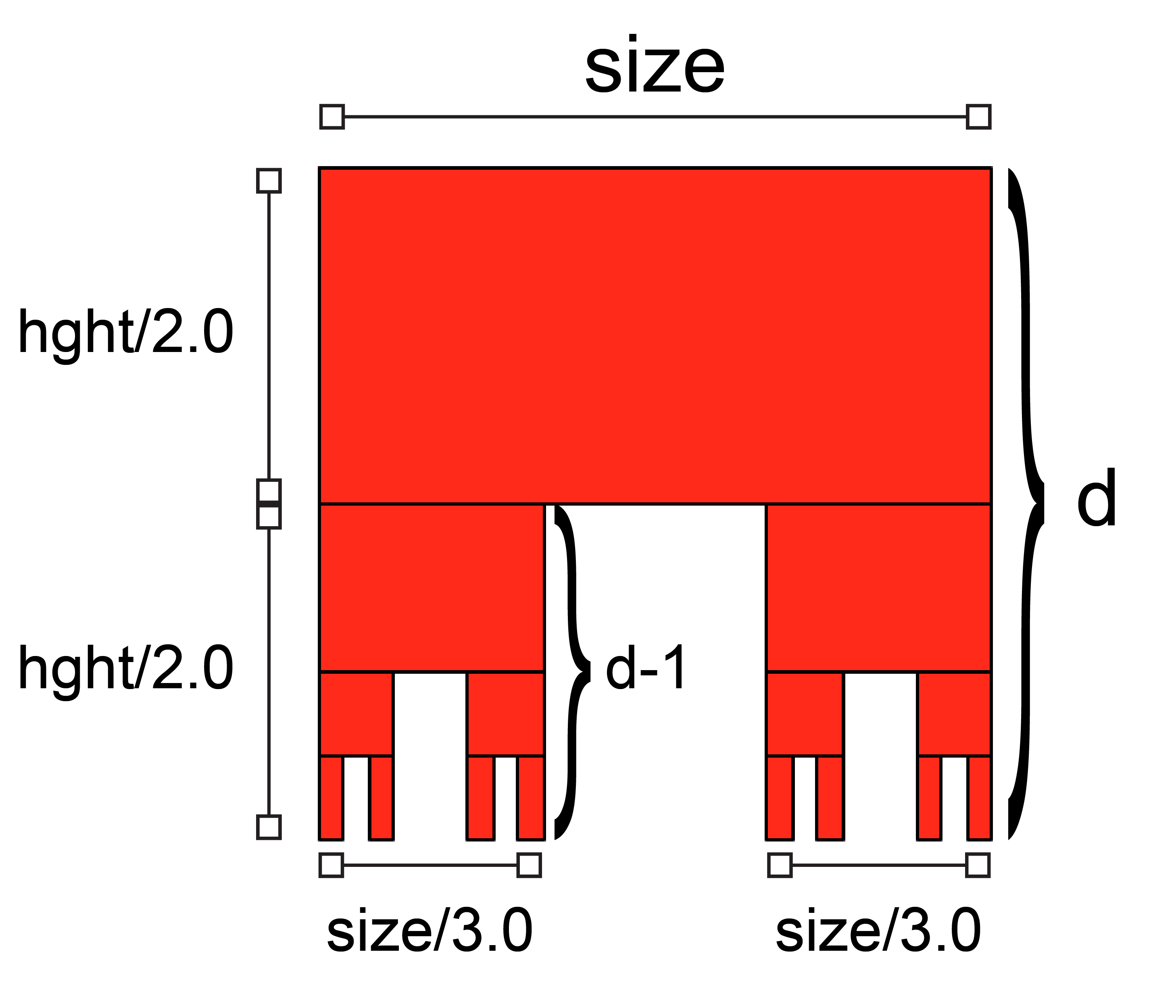
We have stubbed in the procedures cantor and cantor_helper for
you to complete. We have provided a procedure fill_rectangle, which you can
use to draw a solid triangle. You should not modify fill_rectangle
(even though it is missing asserts).
Sierpinski Triangles
There are a lot of fractals named after Sierpinski. Some of you may have seen examples of this in your Calculus class, like the Sierpinski Carpet or Sierpinski snowflake. In these fractals you start with a basic shape (a rectangle or hexagon) and recursively punch holes in the middle. The Sierpinski Triangle is similar except that it works with triangles.
Below are the triangles for depths 0, 1, 2, and 3 respectively. In depth 0, there is
no recursive call and so it is just an equilateral triangle whose sides are length
side. In depth 1, there is a single recursive call and so break up that
triangle into four smaller triangles and remove the middle one. At depth 2, we break
up the remaining hexagons, and so on.
 |
 |
 |
 |
| Depth 0 | Depth 1 | Depth 2 | Depth 3 |
We have stubbed in the procedures sierpinski and sierpinski_helper
for you to complete. We have provided a procedure fill_triangle, which you
can use to draw a solid triangle. You should not modify fill_triangle
(even though it is missing asserts).

When you draw this shape, do not try to "erase" the middle by drawing a white triangle. Instead, you should just refuse to draw it. Except in the base case, only draw the outer four triangles. Those triangles should be Sierpinski triangles of one less depth.
Task 5. 3-Branches Tree
The 3-branches tree is different from the shapes in Part 4 in that it is a line drawing and not a solid shape. The basic shape is a single vertical line. Later shapes branch to the west, east and north half-way up the vertical line. These branches are themselves 3-branches trees of one less depth.
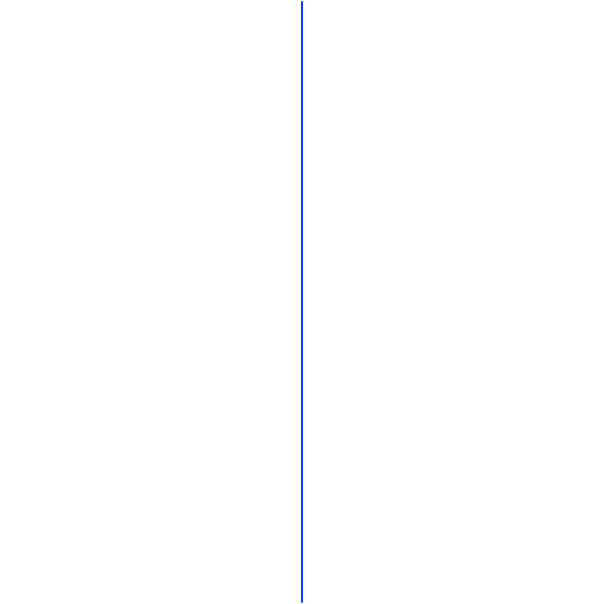 |
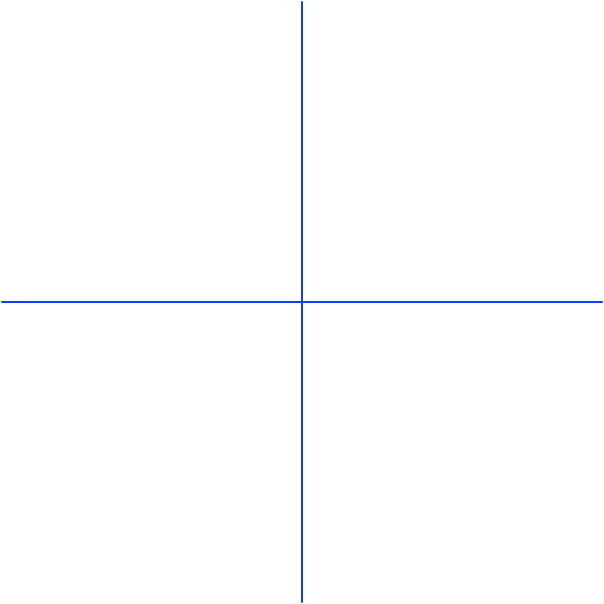 |
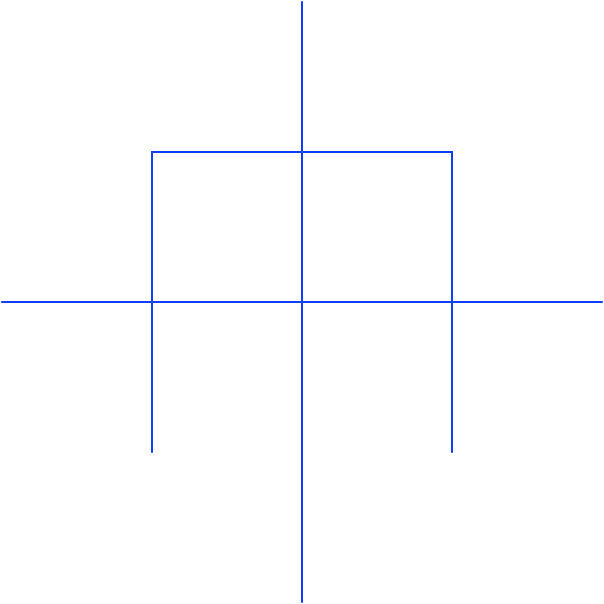 |
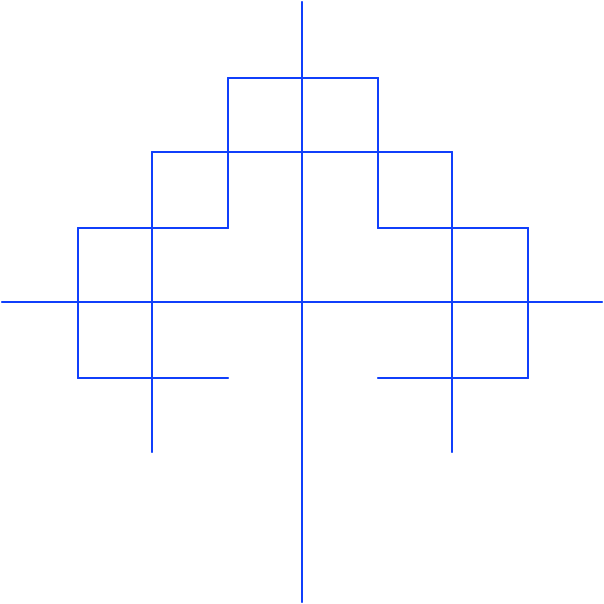 |
|||
| Depth 0 | Depth 1 | Depth 2 | Depth 3 |
Because this is a line drawing, you will be using the Turtle once again. Using the Turtle to draw a recursive shape can be quite tricky because you have to pay very close attention to the orientation. This last task will demonstrate why we are so adamant about restoring the Turtle state at the end of a function. If you do not do that correctly, the Turtle will wander off screen and you will have no idea how to debug it.
The correct orientation of the Turtle is shown by the image below. The Turtle starts off at the bottom facing upwards (Step 1). Once it reaches halfway up the vertical line, it turns left (Step 2) and draws a 3-branches tree of one less depth. When done, it returns to its original position (Step 3), which is in the center facing left. It then turns 90 degrees right (Step 4) and draws another tree of one less depth. When done, it returns to its position (Step 5) and then turns 90 degrees right again (Step 6). It draws one last tree. Finally it returns to its position in the middle (Step 7) before going back to its initial position at the bottom (Step 8)
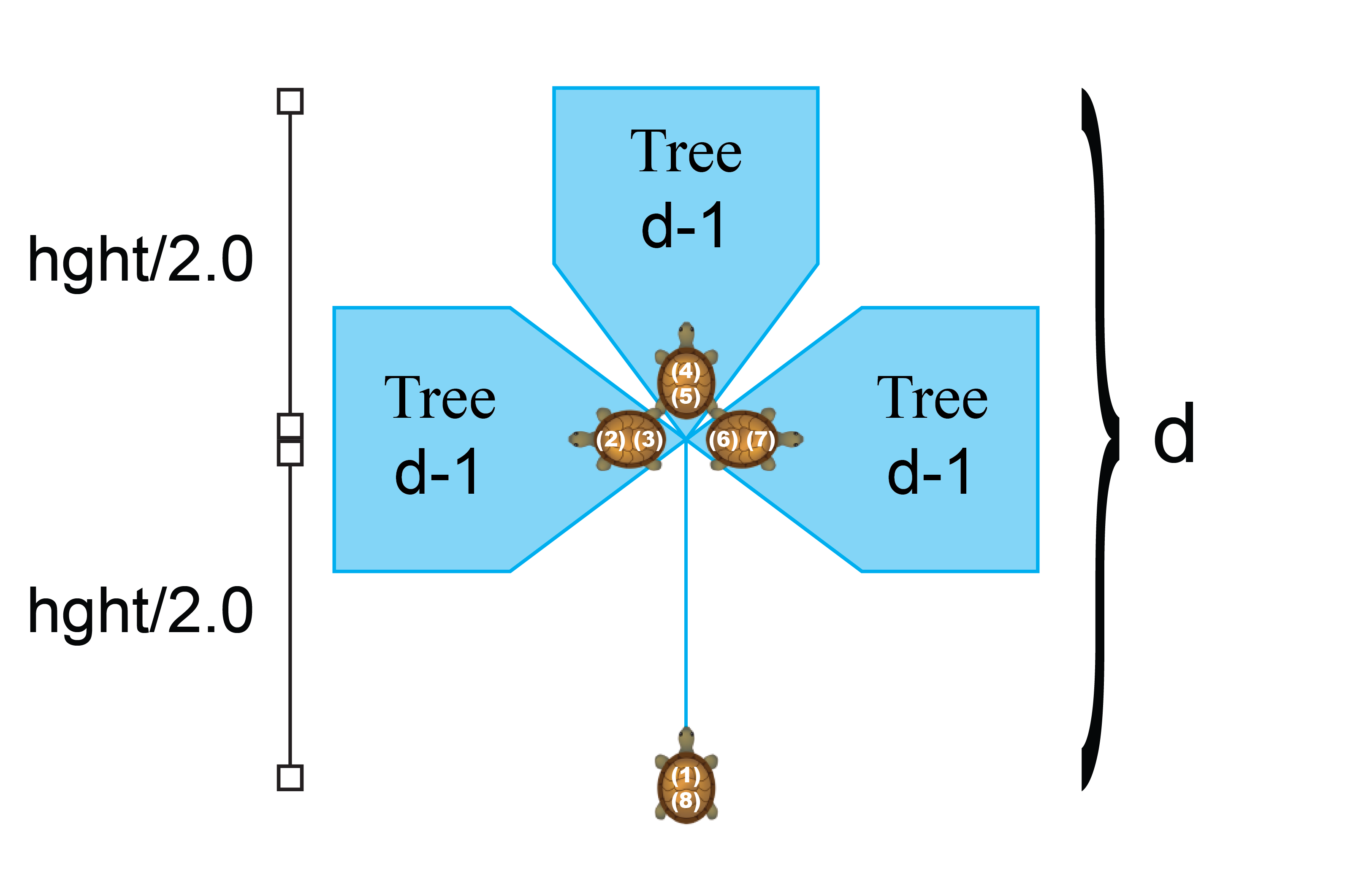
We have stubbed in the procedures branches and branches_helper
for you to complete. You will notice that, while branches assumes the
Turtle starts at the bottom facing up, branches_helper does not. That is
because branches_helper must be able to draw the tree in several different
orientations.
If you are unsure of how to approach this function, look at the Hilbert curve example from class. This example uses a Turtle to recursively draw a shape in much the same way.
3-branches trees are particularly spectacular for large recursion depths. For example, the picture below is for depth 6. Note that it can take a long time to draw this shape, however. Each depth that you add effectively doubles the drawing time for the Turtle.
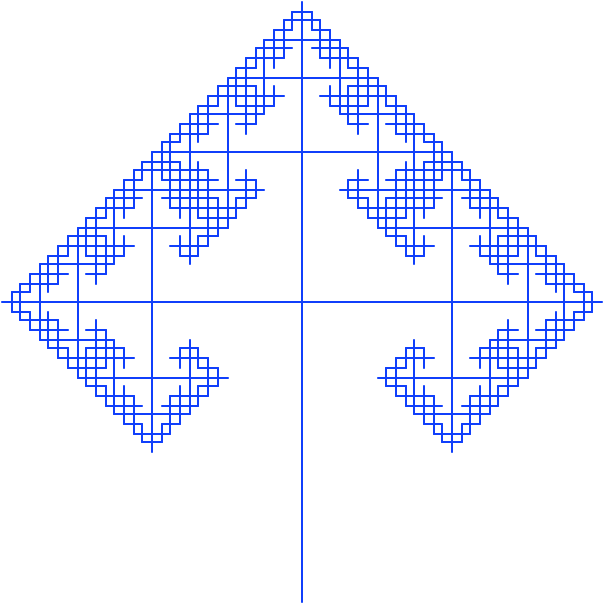
3-Branches Tree (Depth 6)
Finishing the Assignment
Before you submit this assignment, you should be sure that everything is working and polished. Unlike the first assignment, you only get one submission for this assignment. If you make a mistake, you will not get an opportunity to correct it. With that said, you may submit multiple times before the due date. We will grade the most recent version submitted.
Once you have everything working you should go back and make sure that your program meets the class coding conventions. In particular, you should check that the following are all true:
- There are no tabs in the file, only spaces (this is not an issue if you used Komodo Edit).
- Functions are each separated by two blank lines.
- Lines are short enough (80 chars) that horizontal scrolling is not necessary.
- The specifications for all of the functions are complete and are docstrings.
- Specifications are immediately after the function header and indented.
At the top of a4.py you should have three single line comments
with (1) the module name, (2) your name(s) and netid(s), and (3) the date you finished
the assignment. Upload this file to CMS by the due date: Thursday, October 27th at 11:59 pm.
Do not submit any files with the extension/suffix .pyc. It will
help to set the preferences in your operating system so that extensions always
appear.
Survey
In addition to turning in the assignment, we ask that you complete the survey posted in CMS. Once again, the surveys will ask about things such as how long you spent on the assignment, your impression of the difficulty, and what could be done to improve it. Please try to complete the survey within a day of turning in this assignment. Remember that participation in surveys comprise 1% of your final grade.